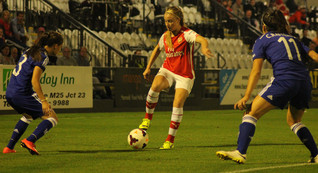
But we watched the opponent go up 1-0, then 2-0, then 3-0.
While they were evenly matched on all things soccer and their sport specific skills there was a clear and distinct difference and you saw it clear as day. It looked like they were always at least two steps behind. The opponent at one point was literally running circles around them.
We could argue soccer skills were even or in our team’s favor. But there was no arguing that their opponents were faster, a lot faster and faster for longer.

The first half of that quote is 100% true of a lot of athletes, a vast majority of athletes would of course benefit greatly from getting quicker. However, the second part is the part where the “gray” area comes into play. Working specifically on speed isn’t what necessarily makes someone quicker.
Wait, what? Let me elaborate.
I’ll tell you if an athlete cannot touch his or her toes, cannot adequately perform functional movements in a full and complete range of motion or does not have the requisite level of strength to sustain impact with adequate deceleration strength – specific speed drills and other plyometrics will do more harm than good and will not make the athlete faster.
HOW to get to quicker and work on speed is the question. After a very specific amount of other needs are met (like the aforementioned), then the sole focus of getting quicker becomes working on speed specific drills and techniques but not before all the pre-requisites are met.

Mobility then Stability then Relative Strength then Absolute Strength then Power/Speed.
Reading that in isolation may make it seem more overwhelming than it actually is. Let’s break it down.
Mobility First
This used to be a debate in the athletic and sports performance world but it is slowly fading and everyone is agreeing that you need to have a standard of mobility (or flexibility or range of motion) to support speed, power and athletic movement.
This really comes down to common sense. Your upper body needs to have mobility in the thoracic spine (upper back/scapula/shoulder blade area) and your lower body needs to have mobility throughout the hips in order to allow the area between it, the trunk or core to do its primary function – stabilize.
If your thoracic spine or your hips are restricted, the body will try to get the range from somewhere else, the majority of the time that means above or below it which usually results in a core that can’t transfer power because it is trying to be a mobility area rather than a stability area.
And on the opposite side, which we see in a lot of female athletes, if your thoracic spine or scapula and the hips are hypermobile or can get into ranges of motion that exceed the standards and safety, you will have the same issues except instead of trying to gain mobility from an area that doesn’t support it, you don’t have stability from anywhere, which ties into our next point about stability.
Bottom line – being adequately mobile is required to produce power and speed. If there is a deficit, your body cannot get enough range to exhibit adequate power and if it has an excess, it won’t be able to stabilize to get the strength to exhibit adequate power.

While you need mobility before stability, stability is the most important factor. The best analogy about stability comes from functional movement specialist, Gray Cook, who coined the phrase, “You can’t shoot a cannon out of a canoe.”
Say you are in the ocean in the sport of shooting down pirate ships – you are the biggest and baddest most advanced cannon there is, except the only foundation you have to shoot off of is a tiny little canoe that isn’t even wide enough for your base. What happens when you fire? You sink or at best fire a shot that doesn’t go very far.
You would actually lose in a battle with a cannon half your size that’s foundation is a battleship. Your body works the same way. If you go for an explosive first step in your sprint and you are exploding off a canoe rather than a battleship, you aren’t going to be very fast.
Stability is often what people refer to as the “X Factor” the thing you can’t quite put your finger on that separates the great from the good when it comes to athletic performance. Why does Jack respond to ladder drills and speed work better than Joe? Because his stability and foundation is better.
What is “stability” is usually the next question and we will answer that in later articles but the bottom line here is it is the ability to stabilize and transmit strength, power and force.
Relative Strength
We see the High School football athlete who can quarter squat 300 pounds on a barbell but cannot perform one proper full, hamstrings to calves with a neutral spine squat. And that speaks to relative strength a lot but it also speaks to mobility and stability as well.
Relative Strength in the context of sport and athletic performance is more specific to how the athlete controls their own bodyweight. Are they functionally strong and adequately mobile in all movement patterns and directions with their bodyweight? Can they safely land in a jump or a change of direction? You need this before going into really progressing in external load.
Absolute Strength is how strong you are in terms of external load (in whatever exercise or movement), Speed is how quickly can you do it and Power is the combination of those two. Once we’ve gotten to this point, all three modalities can be trained cohesively and successfully in a well-managed program that balances all three. The point here is the effectiveness of those aspects is fully dependent on those that preceded it – mobility, stability and relative strength.





 RSS Feed
RSS Feed